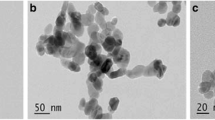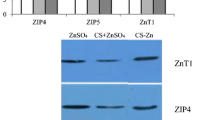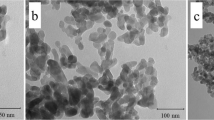Abstract
To investigate the long-term effects of dietary zinc oxide nanoparticle (Nano-ZnO, 20–40 nm) on the relative organ weight, liver function, deposition, and absorption of trace minerals in intrauterine growth retardation (IUGR) pigs, piglets were allocated to NBW (6 normal birth weight piglets fed basal diets), IUGR (6 IUGR piglets fed basal diets) and IUGR+NZ (6 IUGR piglets fed basal diets + 600 mg Zn/kg from Nano-ZnO) groups at weaning (21 days of age), which were sampled at 163 days of age. There were no noteworthy changes in the relative weight of organs, hepatic histomorphology, serum alkaline phosphatase, glutamic pyruvic transaminase and glutamic oxalacetic transaminase activities, and Mn, Cu, and Fe concentrations in leg muscle, the liver, the tibia, and feces among the IUGR, NBW, and IUGR+NZ groups (P>0.05), and no intact Nano-ZnO in the jejunum, liver, and muscle was observed, while dietary Nano-ZnO increased the Zn concentrations in the tibia, the liver, serum, and feces (P<0.05) and mRNA expression of metallothionein (MT) 1A, MT2A, solute carrier family 39 member (ZIP) 4, ZIP14, ZIP8, divalent metal transporter 1, solute carrier family 30 member (ZnT) 1, ZnT4 and metal regulatory transcription factor 1, and ZIP8 protein expression in jejunal mucosa (P<0.05). Immunohistochemistry showed that dietary Nano-ZnO increased the relative optical density of ZIP8 (mainly expressed in cells of brush border) and MT2A (mainly expressed in villus lamina propria and gland/crypt) (P<0.05). In conclusion, long-term dietary Nano-ZnO showed no obvious side effects on the development of the major organs, liver function, and metabolism of Cu, Fe, and Mn in IUGR pigs, while it increased the Zn absorption and deposition via enhancing the expression of transporters (MT, ZIP, and ZnT families) in the jejunum, rather than via endocytosis as the form of intact nanoparticles.





Similar content being viewed by others
Data Availability
The data and materials of this study are available from the corresponding author upon reasonable request.
References
Liao C, Jin Y, Li Y, Tjong SC (2020) Interactions of zinc oxide nanostructures with mammalian cells: cytotoxicity and photocatalytic toxicity. Int J Mol Sci 21:6305. https://doi.org/10.3390/ijms21176305
Singh T, Shukla S, Kumar P, Wahla V, Bajpai VK (2017) Application of nanotechnology in food science: perception and overview. Front Microbiol 8:1501. https://doi.org/10.3389/fmicb.2017.01501
Singh TA, Sharma A, Tejwan N, Ghosh N, Das J, Sil PC (2021) A state of the art review on the synthesis, antibacterial, antioxidant, antidiabetic and tissue regeneration activities of zinc oxide nanoparticles. Adv Colloid Interface Sci 295:102495. https://doi.org/10.1016/j.cis.2021.102495
Singh TA, Das J, Sil PC (2020) Zinc oxide nanoparticles: a comprehensive review on its synthesis, anticancer and drug delivery applications as well as health risks. Adv Colloid Interface Sci 286:102317. https://doi.org/10.1016/j.cis.2020.102317
Mishra PK, Mishra H, Ekielski A, Talegaonkar S, Vaidya B (2017) Zinc oxide nanoparticles: a promising nanomaterial for biomedical applications. Drug Discov Today 22:1825–1834. https://doi.org/10.1016/j.drudis.2017.08.006
Ma H, Williams PL, Diamond SA (2013) Ecotoxicity of manufactured ZnO nanoparticles--a review. Environ Pollut 172:76–85. https://doi.org/10.1016/j.envpol.2012.08.011
Sun YB, Xia T, Wu H, Zhang WJ, Zhu YH, Xue JX, He DT, Zhang LY (2019) Effects of nano zinc oxide as an alternative to pharmacological dose of zinc oxide on growth performance, diarrhea, immune responses, and intestinal microflora profile in weaned piglets. Anim Feed Sci Technol 258:114312. https://doi.org/10.1016/j.anifeedsci.2019.114312
Oh HJ, Park YJ, Cho JH, Song MH, Gu BH, Yun W, Lee JH, An JS, Kim YJ, Lee JS, Kim S, Kim H, Kim ES, Lee BK, Kim BW, Kim HB, Cho JH, Kim MH (2021) Changes in diarrhea score, nutrient digestibility, zinc utilization, intestinal immune profiles, and fecal microbiome in weaned piglets by different forms of zinc. Animals 11:1356. https://doi.org/10.3390/ani11051356
Zhang J, Yu C, Li Z, Li J, Chen Y, Wang T, Wang C (2022) Effects of zinc oxide nanoparticles on growth, intestinal barrier, oxidative status and mineral deposition in 21-day-old broiler chicks. Biol Trace Elem Res 200:1826–1834. https://doi.org/10.1007/s12011-021-02771-6
Sharma V, Singh P, Pandey AK, Dhawan A (2012) Induction of oxidative stress, DNA damage and apoptosis in mouse liver after sub-acute oral exposure to zinc oxide nanoparticles. Mutat Res 745:84–91. https://doi.org/10.1016/j.mrgentox.2011.12.009
Wang J, Zhu X, Guo Y, Wang Z, Zhao B, Yin Y, Liu G (2016) Influence of dietary copper on serum growth-related hormone levels and growth performance of weanling pigs. Biol Trace Elem Res 172:134–139. https://doi.org/10.1007/s12011-015-0574-2
Mahmoud MAM, Yahia D, Abdel-Magiud DS, Darwish MHA, Abd-Elkareem M, Mahmoud UT (2021) Broiler welfare is preserved by long-term low-dose oral exposure to zinc oxide nanoparticles: preliminary study. Nanotoxicology 15:605–620. https://doi.org/10.1080/17435390.2021.1905099
Wang C, Zhang L, Ying Z, He J, Zhou L, Zhang L, Zhong X, Wang T (2018) Effects of dietary zinc oxide nanoparticles on growth, diarrhea, mineral deposition, intestinal morphology, and barrier of weaned piglets. Biol Trace Elem Res 185:364–374. https://doi.org/10.1007/s12011-018-1266-5
Wang C, Zhang L, Su W, Ying Z, He J, Zhang L, Zhong X, Wang T (2017) Zinc oxide nanoparticles as a substitute for zinc oxide or colistin sulfate: effects on growth, serum enzymes, zinc deposition, intestinal morphology and epithelial barrier in weaned piglets. PLoS One 12:e0181136. https://doi.org/10.1371/journal.pone.0181136
Wu G, Bazer FW, Wallace JM, Spencer TE (2006) Board-invited review: intrauterine growth retardation: implications for the animal sciences. J Anim Sci 84:2316–2337. https://doi.org/10.2527/jas.2006-156
Zhang H, Chen Y, Li Y, Wang T (2020) Protective effect of polydatin on jejunal mucosal integrity, redox status, inflammatory response, and mitochondrial function in intrauterine growth-retarded weanling piglets. Oxid Med Cell Longev 2020:7178123. https://doi.org/10.1155/2020/7178123
Yun Y, Ji S, Yu G, Jia P, Niu Y, Zhang H, Zhang X, Wang T, Zhang L (2021) Effects of Bacillus subtilis on jejunal integrity, redox status, and microbial composition of intrauterine growth restriction suckling piglets. J Anim Sci 99:skab255. https://doi.org/10.1093/jas/skab255
Yan E, Zhang J, Han H, Wu J, Gan Z, Wei C, Zhang L, Wang C, Wang T (2019) Curcumin alleviates IUGR jejunum damage by increasing antioxidant capacity through Nrf2/Keap1 pathway in growing pigs. Animals 10:41. https://doi.org/10.3390/ani10010041
Zhou B, Zhang J, Liu H, Chen S, Wang T, Wang C (2022) Zinc oxide nanoparticle improves the intestinal function of intrauterine growth retardation finishing pigs via regulating intestinal morphology, inflammation, antioxidant status and autophagy. Front Vet Sci 9:884945. https://doi.org/10.3389/fvets.2022.884945
Dong L, Zhong X, He J, Zhang L, Bai K, Xu W, Wang T, Huang X (2016) Supplementation of tributyrin improves the growth and intestinal digestive and barrier functions in intrauterine growth-restricted piglets. Clin Nutr 35:399–407. https://doi.org/10.1016/j.clnu.2015.03.002
Bacchetta R, Maran B, Marelli M, Santo N, Tremolada P (2016) Role of soluble zinc in ZnO nanoparticle cytotoxicity in Daphnia magna: a morphological approach. Environ Res 148:376–385. https://doi.org/10.1016/j.envres.2016.04.028
Santo N, Fascio U, Torres F, Guazzoni N, Tremolada P, Bettinetti R, Mantecca P, Bacchetta R (2014) Toxic effects and ultrastructural damages to Daphnia magna of two differently sized ZnO nanoparticles: does size matter? Water Res 53:339–350. https://doi.org/10.1016/j.watres.2014.01.036
Grecchi S, Malatesta M (2014) Visualizing endocytotic pathways at transmission electron microscopy via diaminobenzidine photo-oxidation by a fluorescent cell-membrane dye. Eur J Histochem 58:2449. https://doi.org/10.4081/ejh.2014.2449
Shrivastava R, Raza S, Yadav A, Kushwaha P, Flora SJ (2014) Effects of sub-acute exposure to TiO2, ZnO and Al2O3 nanoparticles on oxidative stress and histological changes in mouse liver and brain. Drug Chem Toxicol 37:336–347. https://doi.org/10.3109/01480545.2013.866134
Sahayam AC, Chaurasia SC, Venkateswarlu G (2010) Dry ashing of organic rich matrices with palladium for the determination of arsenic using inductively coupled plasma-mass spectrometry. Anal Chim Acta 661:17–19. https://doi.org/10.1016/j.aca.2009.12.010
Livak KJ, Schmittgen TD (2001) Analysis of relative gene expression data using real-time quantitative PCR and the 2(-Delta Delta C(T)) method. Methods 25:402–408. https://doi.org/10.1006/meth.2001.1262
Cheng K, Yu C, Li Z, Li S, Yan E, Song Z, Zhang H, Zhang L, Wang T (2020) Resveratrol improves meat quality, muscular antioxidant capacity, lipid metabolism and fiber type composition of intrauterine growth retarded pigs. Meat Sci 170:108237. https://doi.org/10.1016/j.meatsci.2020.108237
Qi L, Jiang J, Zhang J, Zhang L, Wang T (2022) Effect of maternal curcumin supplementation on intestinal damage and the gut microbiota in male mice offspring with intra-uterine growth retardation. Eur J Nutr 61:1875–1892. https://doi.org/10.1007/s00394-021-02783-x
Wang QM, Huang XY, Guan WQ (2022) Expressions of interleukin-27 in oral lichen planus, oral leukoplakia, and oral squamous cell carcinoma. Inflammation 45:1023–1038. https://doi.org/10.1007/s10753-021-01599-5
Chen Y, Zhang Y, He J, Fu Y, Lin C, Li X (2017) MicroRNA-133b is regulated by TAp63 while no gene mutation is present in colorectal cancer. Oncol Rep 37:1646–1652. https://doi.org/10.3892/or.2017.5371
Michael B, Yano B, Sellers RS, Perry R, Morton D, Roome N, Johnson JK, Schafer K, Pitsch S (2007) Evaluation of organ weights for rodent and non-rodent toxicity studies: a review of regulatory guidelines and a survey of current practices. Toxicol Pathol 35:742–750. https://doi.org/10.1080/01926230701595292
Sellers RS, Morton D, Michael B, Roome N, Johnson JK, Yano BL, Perry R, Schafer K (2007) Society of Toxicologic Pathology position paper: organ weight recommendations for toxicology studies. Toxicol Pathol 35:751–755. https://doi.org/10.1080/01926230701595300
Wang C, Cheng K, Zhou L, He J, Zheng X, Zhang L, Zhong X, Wang T (2017) Evaluation of long-term toxicity of oral zinc oxide nanoparticles and zinc sulfate in mice. Biol Trace Elem Res 178:276–282. https://doi.org/10.1007/s12011-017-0934-1
Wang C, Lu J, Zhou L, Li J, Xu J, Li W, Zhang L, Zhong X, Wang T (2016) Effects of long-term exposure to zinc oxide nanoparticles on development, zinc metabolism and biodistribution of minerals (Zn, Fe, Cu, Mn) in mice. PLoS One 11:e0164434. https://doi.org/10.1371/journal.pone.0164434
Yasuno T, Okamoto H, Nagai M, Kimura S, Yamamoto T, Nagano K, Furubayashi T, Yoshikawa Y, Yasui H, Katsumi H, Sakane T, Yamamoto A (2011) The disposition and intestinal absorption of zinc in rats. Eur J Pharm Sci 44:410–415. https://doi.org/10.1016/j.ejps.2011.08.024
Cousins RJ (1986) Toward a molecular understanding of zinc metabolism. Clin Physiol Biochem 4(1):20–30
Cheng K, Jia P, Ji S, Song Z, Zhang H, Zhang L, Wang T (2021) Improvement of the hepatic lipid status in intrauterine growth retarded pigs by resveratrol is related to the inhibition of mitochondrial dysfunction, oxidative stress and inflammation. Food Funct 12:278–290. https://doi.org/10.1039/d0fo01459a
Hill GM, Shannon MC (2019) Copper and zinc nutritional issues for agricultural animal production. Biol Trace Elem Res 188:148–159. https://doi.org/10.1007/s12011-018-1578-5
Kociova S, Dolezelikova K, Horky P, Skalickova S, Baholet D, Bozdechova L, Vaclavkova E, Belkova J, Nevrkla P, Skladanka J, Do T, Zitka O, Haddad Y, Kopel P, Zurek L, Adam V, Smerkova K (2020) Zinc phosphate-based nanoparticles as alternatives to zinc oxide in diet of weaned piglets. J Anim Sci Biotechnol 11:59. https://doi.org/10.1186/s40104-020-00458-x
Lukaski HC (2004) Vitamin and mineral status: effects on physical performance. Nutrition 20:632–644. https://doi.org/10.1016/j.nut.2004.04.001
Maggini S, Pierre A, Calder PC (2018) Immune function and micronutrient requirements change over the life course. Nutrients 10:1531. https://doi.org/10.3390/nu10101531
Hoffman HN 2nd, Phyliky RL, Fleming CR (1988) Zinc-induced copper deficiency. Gastroenterology 94:508–512. https://doi.org/10.1016/0016-5085(88)90445-3
Davin R, Manzanilla EG, Klasing KC, Pérez JF (2012) Evolution of zinc, iron, and copper concentrations along the gastrointestinal tract of piglets weaned with or without in-feed high doses of zinc oxide compared to unweaned littermates. J Anim Sci 4:248–250. https://doi.org/10.2527/jas.53999
Rincker MJ, Hill GM, Link JE, Meyer AM, Rowntree JE (2005) Effects of dietary zinc and iron supplementation on mineral excretion, body composition, and mineral status of nursery pigs. J Anim Sci 83:2762–2774. https://doi.org/10.2527/2005.83122762x
Wang X, Zhou B (2010) Dietary zinc absorption: a play of zips and ZnTs in the gut. IUBMB Life 62:176–182. https://doi.org/10.1002/iub.291
Cousins RJ, Liuzzi JP, Lichten LA (2006) Mammalian zinc transport, trafficking, and signals. J Biol Chem 281:24085–24089. https://doi.org/10.1074/jbc.R600011200
Cousins RJ (1985) Absorption, transport, and hepatic metabolism of copper and zinc: special reference to metallothionein and ceruloplasmin. Physiol Rev 65:238–309. https://doi.org/10.1152/physrev.1985.65.2.238
Tran CD, Butler RN, Howarth GS, Philcox JC, Rofe AM, Coyle P (1999) Regional distribution and localization of zinc and metallothionein in the intestine of rats fed diets differing in zinc content. Scand J Gastroenterol 34:689–695. https://doi.org/10.1080/003655299750025895
Garrick MD, Dolan KG, Horbinski C, Ghio AJ, Higgins D, Porubcin M, Moore EG, Hainsworth LN, Umbreit JN, Conrad ME, Feng L, Lis A, Roth JA, Singleton S, Garrick LM (2003) DMT1: a mammalian transporter for multiple metals. Biometals 16:41–54. https://doi.org/10.1023/a:1020702213099
Garrick MD, Singleton ST, Vargas F, Kuo HC, Zhao L, Knöpfel M, Davidson T, Costa M, Paradkar P, Roth JA, Garrick LM (2006) DMT1: which metals does it transport? Biol Res 39:79–85. https://doi.org/10.4067/s0716-97602006000100009
Hardyman JE, Tyson J, Jackson KA, Aldridge C, Cockell SJ, Wakeling LA, Valentine RA, Ford D (2016) Zinc sensing by metal-responsive transcription factor 1 (MTF1) controls metallothionein and ZnT1 expression to buffer the sensitivity of the transcriptome response to zinc. Metallomics 8:337–343. https://doi.org/10.1039/c5mt00305a
Ling SC, Zhuo MQ, Zhang DG, Cui HY, Luo Z (2020) Nano-Zn increased Zn accumulation and triglyceride content by up-regulating lipogenesis in freshwater teleost, yellow catfish pelteobagrus fulvidraco. Int J Mol Sci 21:1615. https://doi.org/10.3390/ijms21051615
Chen SW, Lv WH, Wu K, Chen GH, Chen F, Song CC, Luo Z (2021) Dietary Nano-ZnO is absorbed via endocytosis and ZIP pathways, upregulates lipogenesis, and induces lipotoxicity in the intestine of yellow catfish. Int J Mol Sci 22:12047. https://doi.org/10.3390/ijms222112047
Melia JMP, Lin R, Xavier RJ, Thompson RB, Fu D, Wan F, Sears CL, Donowitz M (2019) Induction of the metal transporter ZIP8 by interferon gamma in intestinal epithelial cells: Potential role of metal dyshomeostasis in Crohn’s disease. Biochem Biophys Res Commun 515:325–331. https://doi.org/10.1016/j.bbrc.2019.05.137
Ensari A, Marsh MN (2018) Exploring the villus. Gastroenterol Hepatol Bed Bench 11(3):181–190. https://doi.org/10.22037/GHFBB.V0I0.1271
Ishii M, Fukuoka Y, Deguchi S, Otake H, Tanino T, Nagai N (2019) Energy-dependent endocytosis is involved in the absorption of indomethacin nanoparticles in the small intestine. Int J Mol Sci 20:476. https://doi.org/10.3390/ijms20030476
Xu D, Ma Y, Han X, Chen Y (2021) Systematic toxicity evaluation of polystyrene nanoplastics on mice and molecular mechanism investigation about their internalization into Caco-2 cells. J Hazard Mater 417:126092. https://doi.org/10.1016/j.jhazmat.2021.126092
Beloqui A, des Rieux A, Preat V (2016) Mechanisms of transport of polymeric and lipidic nanoparticles across the intestinal barrier. Adv Drug Deliv Rev 106:242–255. https://doi.org/10.1016/j.addr.2016.04.014
Benmerah A, Lamaze C, Bègue B, Schmid SL, Dautry-Varsat A, Cerf-Bensussan N (1998) AP-2/Eps15 interaction is required for receptor-mediated endocytosis. J Cell Biol 140:1055–1062. https://doi.org/10.1083/jcb.140.5.1055
Khan I, Steeg PS (2021) Endocytosis: a pivotal pathway for regulating metastasis. Br J Cancer 124:66–75. https://doi.org/10.1038/s41416-020-01179-8
Funding
This study was supported by the National Natural Science Foundation of China (No.31972598).
Author information
Authors and Affiliations
Contributions
Conceived and designed the experiment by Chao Wang and Tian Wang. Experiment preparation and data collection were performed by Binbin Zhou, Jian Li, Shun Chen, Huijuan Liu, Jiaqi Zhang, and Yudan He. Analyzed the data by Binbin Zhou. The first draft of the manuscript was writing by Binbin Zhou. Review and editing the first draft by Chao Wang. All authors have read and agreed to the published version of the manuscript.
Corresponding author
Ethics declarations
Competing Interests
The authors declare no competing interests.
Additional information
Publisher’s Note
Springer Nature remains neutral with regard to jurisdictional claims in published maps and institutional affiliations.
Supplementary Information
ESM 1.
(DOCX 40 kb)
Rights and permissions
Springer Nature or its licensor (e.g. a society or other partner) holds exclusive rights to this article under a publishing agreement with the author(s) or other rightsholder(s); author self-archiving of the accepted manuscript version of this article is solely governed by the terms of such publishing agreement and applicable law.
About this article
Cite this article
Zhou, B., Li, J., Zhang, J. et al. Effects of Long-Term Dietary Zinc Oxide Nanoparticle on Liver Function, Deposition, and Absorption of Trace Minerals in Intrauterine Growth Retardation Pigs. Biol Trace Elem Res 201, 4746–4757 (2023). https://doi.org/10.1007/s12011-022-03547-2
Received:
Accepted:
Published:
Issue Date:
DOI: https://doi.org/10.1007/s12011-022-03547-2




